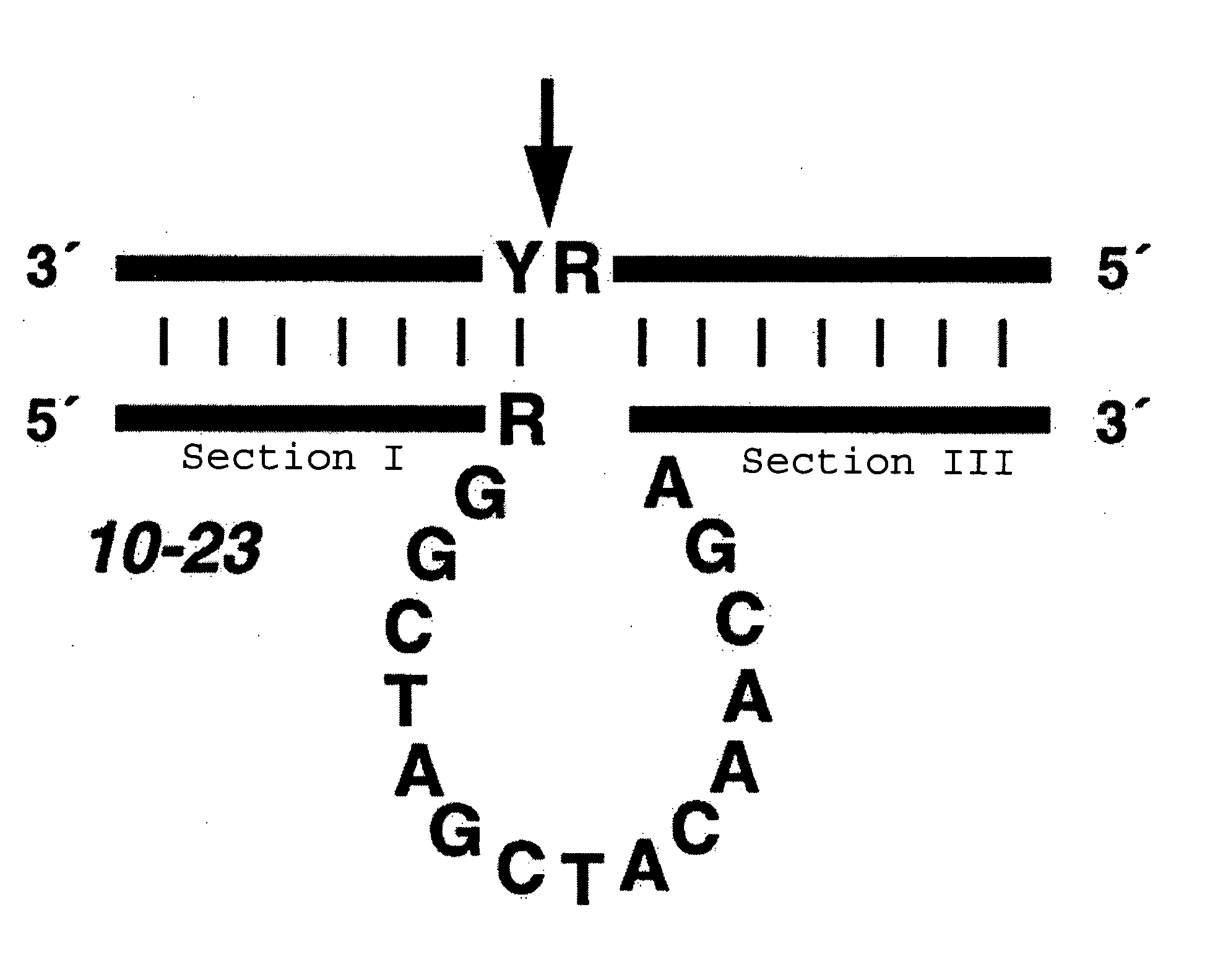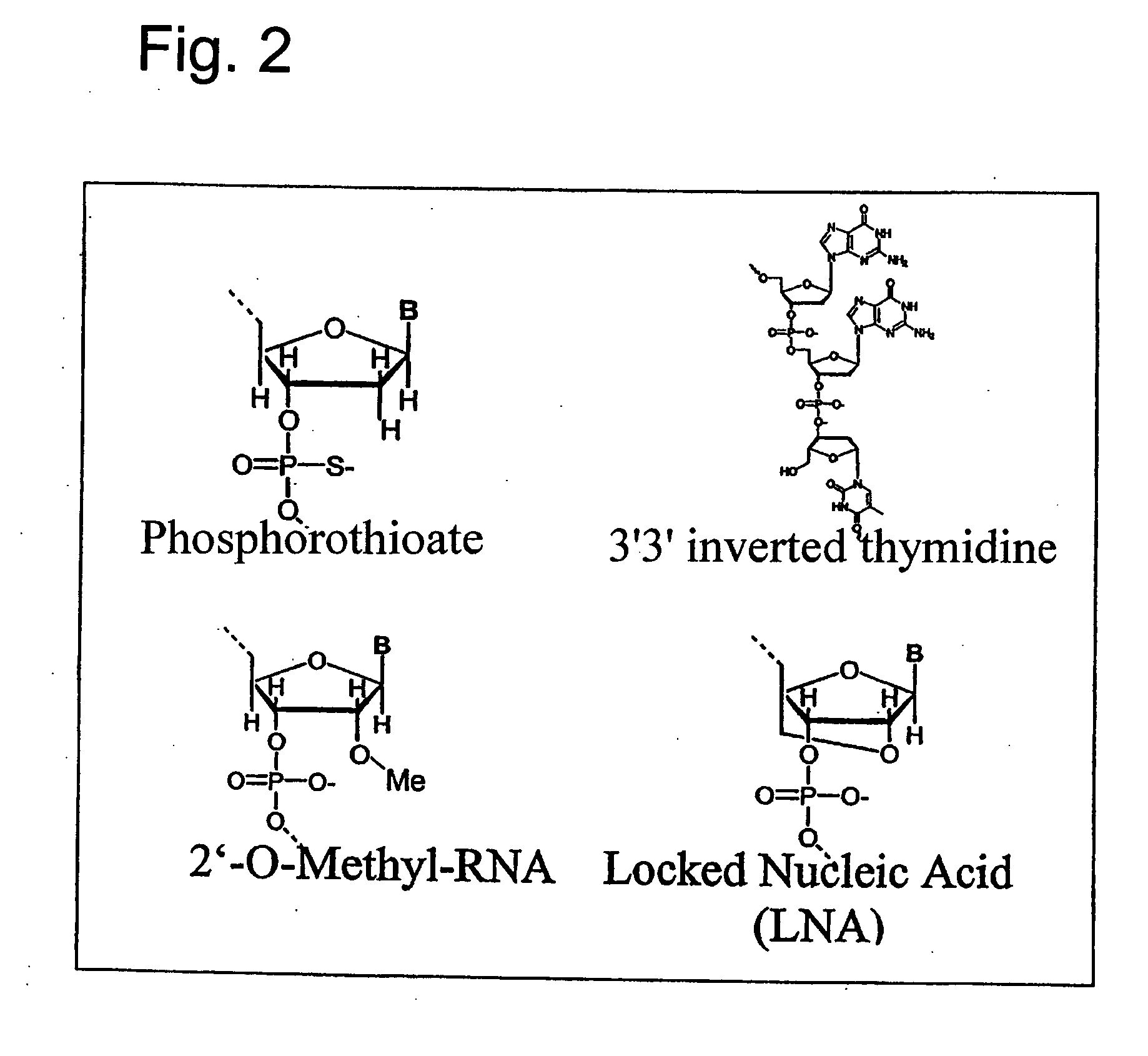Effective and stable DNA enzymes
a dna enzyme, stable technology, applied in the direction of enzymes, sugar derivatives, biochemistry apparatus and processes, etc., can solve the problems of insufficient effectiveness of analgesics known in the art, unsatisfactory pharmacological treatment, in particular chronic pain, etc., and achieve the effect of greater stability in nucleolytic degradation
- Summary
- Abstract
- Description
- Claims
- Application Information
AI Technical Summary
Benefits of technology
Problems solved by technology
Method used
Image
Examples
example 2
Dependence of the reaction Velocity on the Melting Point Between DNA Enzyme and Substrate
[0087] The modifications 2′-O-methyl and LNA ribonucleotides according to the invention increase the affinity for the substrate (i.e. the melting point of the helices formed between section I or III with the target sequence increases). However, for optimum activity under MTO conditions, efficient product release is also necessary, which is why the affinity for the substrate should not be too high. If, therefore, in the case of the DNA enzymes modified according to the invention according to the above Table 1, the initial velocity under MTO conditions (vinit) is plotted in dependence on the melting temperature with the substrate, a correlation is observed between the melting temperature and the reaction velocity, which can be compared in a first approximation to a Gaussian distribution around an optimum at about 39° C. (FIG. 5).
example 3
Effect of Modifications in the Core Sequence on the Activity of DNA Enzymes
[0088] The 15 nucleotides of the core sequence of DH5 were replaced individually by corresponding 2′-O-methyl ribonucleotides, and the reaction velocity under MTO conditions was measured as indicated in Example 1. It was found that nucleotides 2, 7, 8, 9, 11, 14 and 15 could be replaced by modified nucleotides without any loss of activity (FIG. 6). There was even a gain in activity of at least 20%.
[0089] Furthermore, the 6 nucleotides in the case of DH5 were together replaced by 2′-O-methyl ribose-modified nucleotides (construct CM6). The activity was substantially maintained compared with the unmodified construct (FIG. 4; compare CM6 with DH5-9).
[0090] In the case of the DNA enzyme against VR1, the above nucleotides of the core sequence could be modified together, the activity compared with the unmodified construct not only being maintained but an increased activity even being observed:
DV15(unmod.):0.5...
example 4
Effect of the combination of Core Sequence and Substrate Recognition Arm Modifications on the Activity of DNA Enzymes
[0091] The initial reaction velocity under MTO conditions was also studied in the case of the DNA enzyme against human rhinovirus 14 having substrate recognition arms with a length of 7 nucleotides, in which nucleotides 2, 7, 8, 11, 14 and 15 of the core sequence and in each case 5 nucleotides from the end of the substrate recognition arms were replaced by corresponding 2′-O-methyl ribonucleotides.
[0092] The activity of the modified, i.e. completely stabilised, construct compared with the unmodified construct was increased almost 10-fold:
DH5-9 (unmod.):0.21 ± 0.03nM / minDH5-9 (comp. stab.):2.0 ± 0.1nM / min
PUM
| Property | Measurement | Unit |
|---|---|---|
| Melting point | aaaaa | aaaaa |
| Volume | aaaaa | aaaaa |
| Volume | aaaaa | aaaaa |
Abstract
Description
Claims
Application Information
 Login to View More
Login to View More - R&D
- Intellectual Property
- Life Sciences
- Materials
- Tech Scout
- Unparalleled Data Quality
- Higher Quality Content
- 60% Fewer Hallucinations
Browse by: Latest US Patents, China's latest patents, Technical Efficacy Thesaurus, Application Domain, Technology Topic, Popular Technical Reports.
© 2025 PatSnap. All rights reserved.Legal|Privacy policy|Modern Slavery Act Transparency Statement|Sitemap|About US| Contact US: help@patsnap.com



